MBA402: Risk Assessment of Trading.com - A Comprehensive Report
VerifiedAdded on 2022/11/23
|11
|2587
|341
Report
AI Summary
This report provides a comprehensive risk assessment of Trading.com, a fictional company offering financial investment courses. The assessment, conducted as part of an MBA402 assignment, utilizes a risk exposure calculator to evaluate pressure points related to growth, organizational culture, and information management. The analysis delves into factors such as performance pressure, rate of expansion, employee experience, rewards for risk-taking, response to negative news, internal competition, transaction complexity, diagnostic performance gaps, and decentralization of decision-making. The report concludes with an overall risk score and emphasizes the importance of proactive risk management for the company's long-term success. The student used at least 15 references, with a minimum of 5 from academic journals or textbooks.
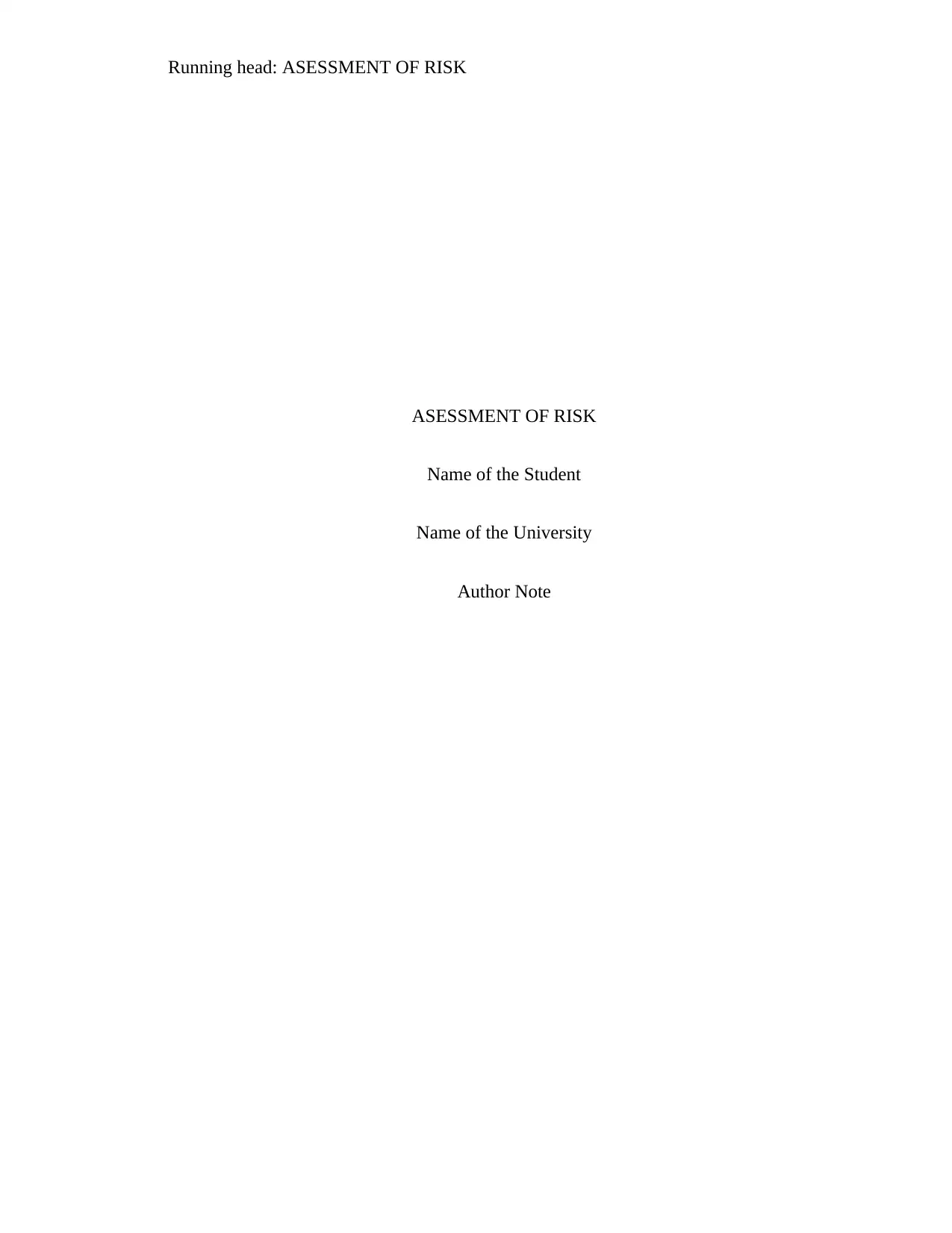
Running head: ASESSMENT OF RISK
ASESSMENT OF RISK
Name of the Student
Name of the University
Author Note
ASESSMENT OF RISK
Name of the Student
Name of the University
Author Note
Paraphrase This Document
Need a fresh take? Get an instant paraphrase of this document with our AI Paraphraser
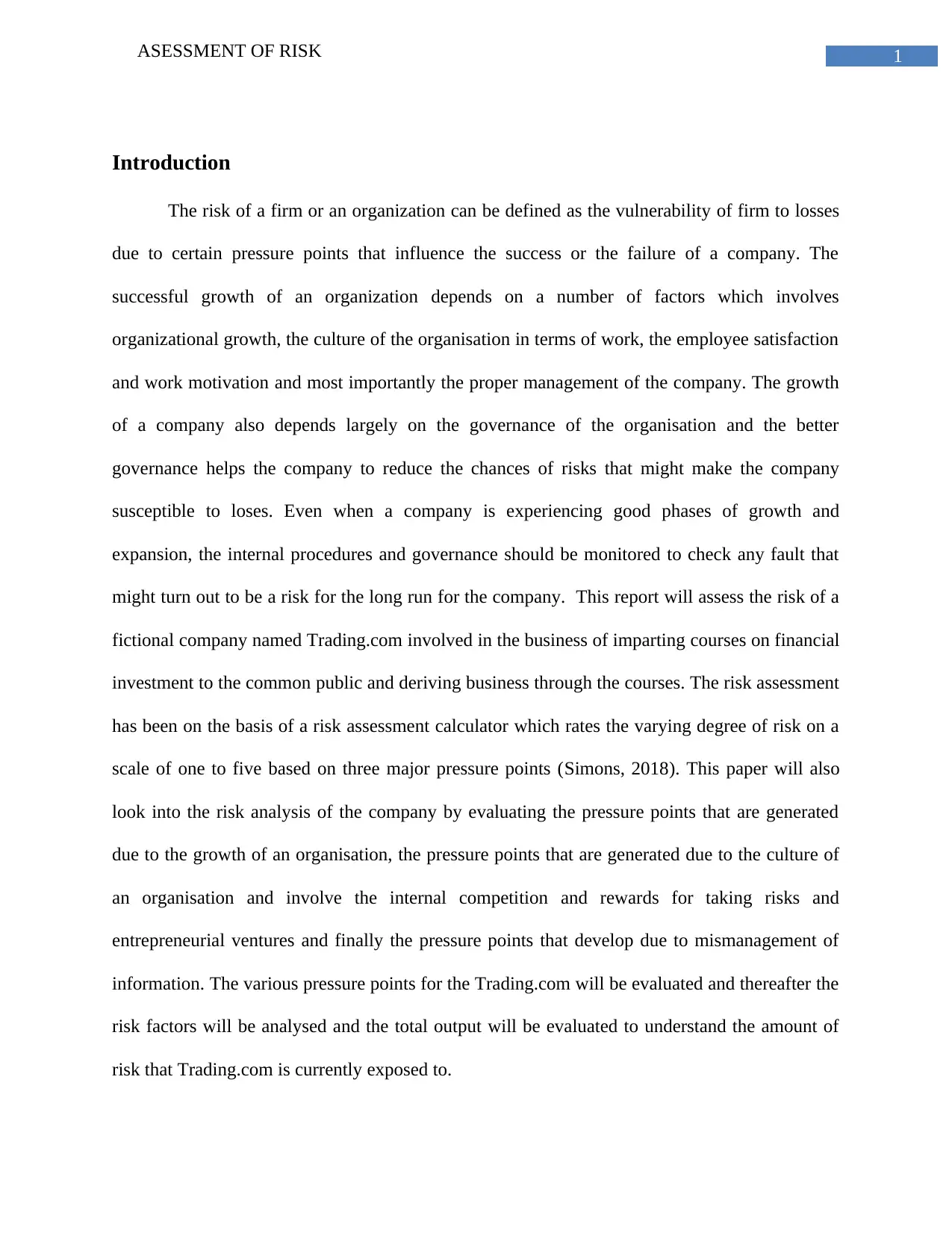
1ASESSMENT OF RISK
Introduction
The risk of a firm or an organization can be defined as the vulnerability of firm to losses
due to certain pressure points that influence the success or the failure of a company. The
successful growth of an organization depends on a number of factors which involves
organizational growth, the culture of the organisation in terms of work, the employee satisfaction
and work motivation and most importantly the proper management of the company. The growth
of a company also depends largely on the governance of the organisation and the better
governance helps the company to reduce the chances of risks that might make the company
susceptible to loses. Even when a company is experiencing good phases of growth and
expansion, the internal procedures and governance should be monitored to check any fault that
might turn out to be a risk for the long run for the company. This report will assess the risk of a
fictional company named Trading.com involved in the business of imparting courses on financial
investment to the common public and deriving business through the courses. The risk assessment
has been on the basis of a risk assessment calculator which rates the varying degree of risk on a
scale of one to five based on three major pressure points (Simons, 2018). This paper will also
look into the risk analysis of the company by evaluating the pressure points that are generated
due to the growth of an organisation, the pressure points that are generated due to the culture of
an organisation and involve the internal competition and rewards for taking risks and
entrepreneurial ventures and finally the pressure points that develop due to mismanagement of
information. The various pressure points for the Trading.com will be evaluated and thereafter the
risk factors will be analysed and the total output will be evaluated to understand the amount of
risk that Trading.com is currently exposed to.
Introduction
The risk of a firm or an organization can be defined as the vulnerability of firm to losses
due to certain pressure points that influence the success or the failure of a company. The
successful growth of an organization depends on a number of factors which involves
organizational growth, the culture of the organisation in terms of work, the employee satisfaction
and work motivation and most importantly the proper management of the company. The growth
of a company also depends largely on the governance of the organisation and the better
governance helps the company to reduce the chances of risks that might make the company
susceptible to loses. Even when a company is experiencing good phases of growth and
expansion, the internal procedures and governance should be monitored to check any fault that
might turn out to be a risk for the long run for the company. This report will assess the risk of a
fictional company named Trading.com involved in the business of imparting courses on financial
investment to the common public and deriving business through the courses. The risk assessment
has been on the basis of a risk assessment calculator which rates the varying degree of risk on a
scale of one to five based on three major pressure points (Simons, 2018). This paper will also
look into the risk analysis of the company by evaluating the pressure points that are generated
due to the growth of an organisation, the pressure points that are generated due to the culture of
an organisation and involve the internal competition and rewards for taking risks and
entrepreneurial ventures and finally the pressure points that develop due to mismanagement of
information. The various pressure points for the Trading.com will be evaluated and thereafter the
risk factors will be analysed and the total output will be evaluated to understand the amount of
risk that Trading.com is currently exposed to.
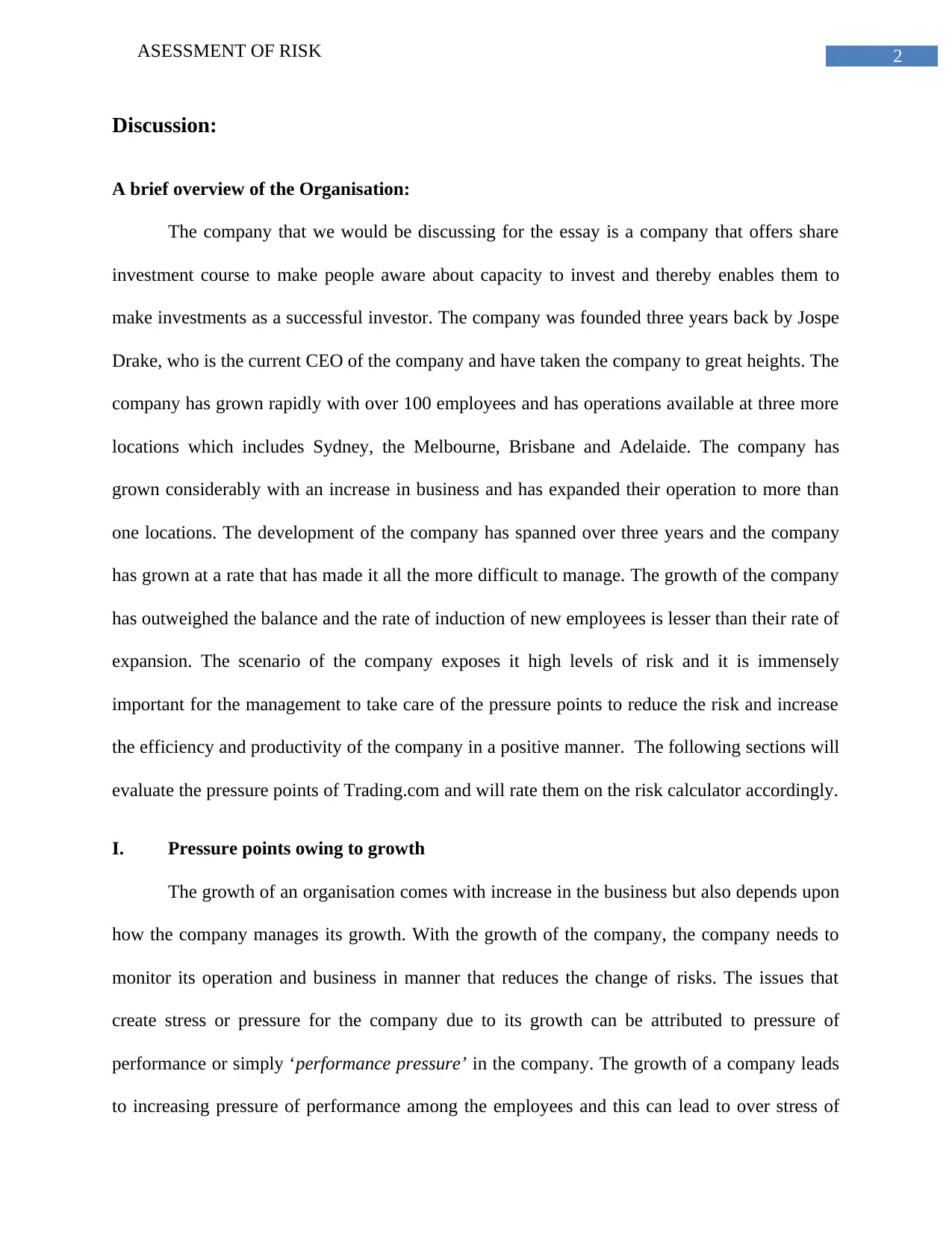
2ASESSMENT OF RISK
Discussion:
A brief overview of the Organisation:
The company that we would be discussing for the essay is a company that offers share
investment course to make people aware about capacity to invest and thereby enables them to
make investments as a successful investor. The company was founded three years back by Jospe
Drake, who is the current CEO of the company and have taken the company to great heights. The
company has grown rapidly with over 100 employees and has operations available at three more
locations which includes Sydney, the Melbourne, Brisbane and Adelaide. The company has
grown considerably with an increase in business and has expanded their operation to more than
one locations. The development of the company has spanned over three years and the company
has grown at a rate that has made it all the more difficult to manage. The growth of the company
has outweighed the balance and the rate of induction of new employees is lesser than their rate of
expansion. The scenario of the company exposes it high levels of risk and it is immensely
important for the management to take care of the pressure points to reduce the risk and increase
the efficiency and productivity of the company in a positive manner. The following sections will
evaluate the pressure points of Trading.com and will rate them on the risk calculator accordingly.
I. Pressure points owing to growth
The growth of an organisation comes with increase in the business but also depends upon
how the company manages its growth. With the growth of the company, the company needs to
monitor its operation and business in manner that reduces the change of risks. The issues that
create stress or pressure for the company due to its growth can be attributed to pressure of
performance or simply ‘performance pressure’ in the company. The growth of a company leads
to increasing pressure of performance among the employees and this can lead to over stress of
Discussion:
A brief overview of the Organisation:
The company that we would be discussing for the essay is a company that offers share
investment course to make people aware about capacity to invest and thereby enables them to
make investments as a successful investor. The company was founded three years back by Jospe
Drake, who is the current CEO of the company and have taken the company to great heights. The
company has grown rapidly with over 100 employees and has operations available at three more
locations which includes Sydney, the Melbourne, Brisbane and Adelaide. The company has
grown considerably with an increase in business and has expanded their operation to more than
one locations. The development of the company has spanned over three years and the company
has grown at a rate that has made it all the more difficult to manage. The growth of the company
has outweighed the balance and the rate of induction of new employees is lesser than their rate of
expansion. The scenario of the company exposes it high levels of risk and it is immensely
important for the management to take care of the pressure points to reduce the risk and increase
the efficiency and productivity of the company in a positive manner. The following sections will
evaluate the pressure points of Trading.com and will rate them on the risk calculator accordingly.
I. Pressure points owing to growth
The growth of an organisation comes with increase in the business but also depends upon
how the company manages its growth. With the growth of the company, the company needs to
monitor its operation and business in manner that reduces the change of risks. The issues that
create stress or pressure for the company due to its growth can be attributed to pressure of
performance or simply ‘performance pressure’ in the company. The growth of a company leads
to increasing pressure of performance among the employees and this can lead to over stress of
⊘ This is a preview!⊘
Do you want full access?
Subscribe today to unlock all pages.

Trusted by 1+ million students worldwide
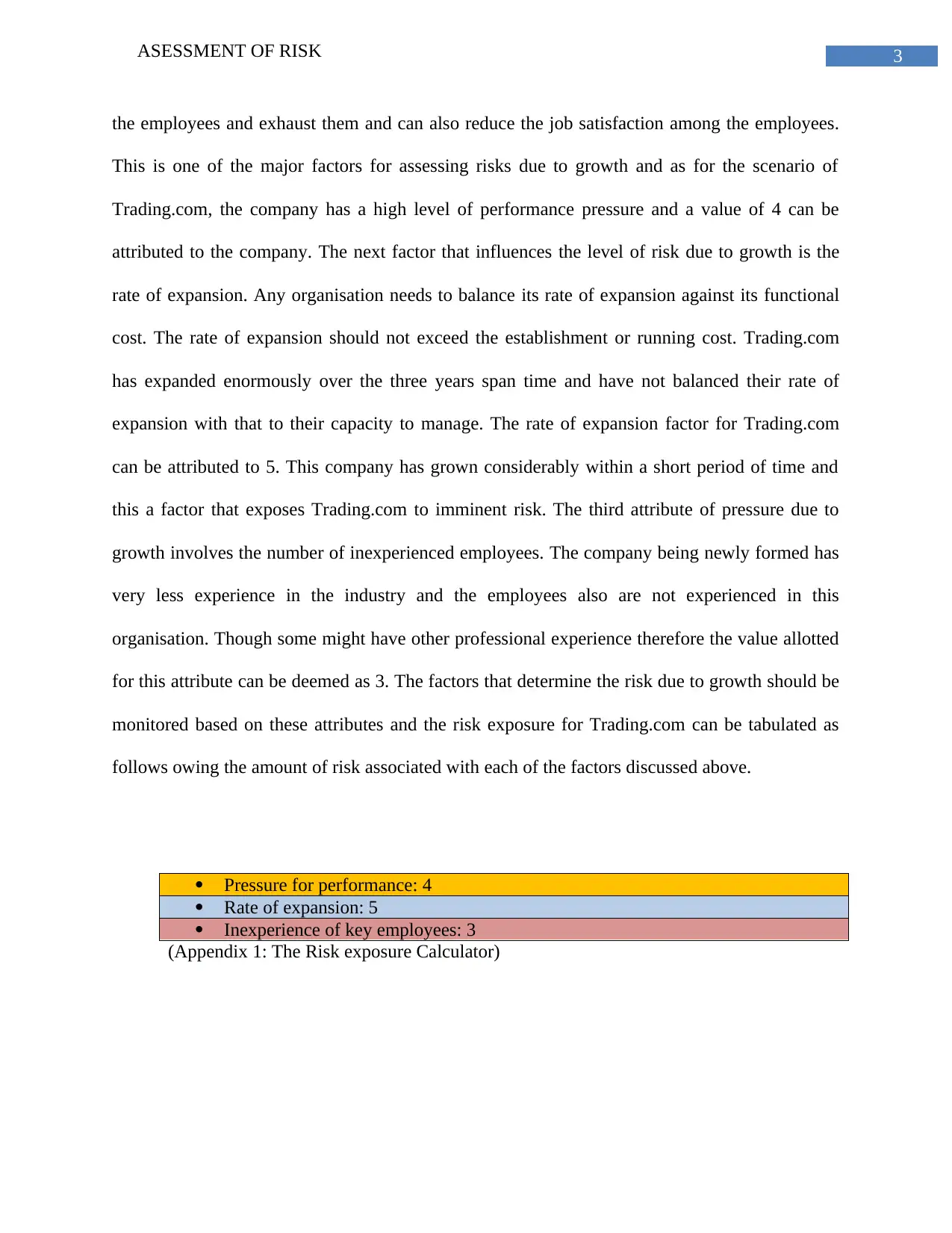
3ASESSMENT OF RISK
the employees and exhaust them and can also reduce the job satisfaction among the employees.
This is one of the major factors for assessing risks due to growth and as for the scenario of
Trading.com, the company has a high level of performance pressure and a value of 4 can be
attributed to the company. The next factor that influences the level of risk due to growth is the
rate of expansion. Any organisation needs to balance its rate of expansion against its functional
cost. The rate of expansion should not exceed the establishment or running cost. Trading.com
has expanded enormously over the three years span time and have not balanced their rate of
expansion with that to their capacity to manage. The rate of expansion factor for Trading.com
can be attributed to 5. This company has grown considerably within a short period of time and
this a factor that exposes Trading.com to imminent risk. The third attribute of pressure due to
growth involves the number of inexperienced employees. The company being newly formed has
very less experience in the industry and the employees also are not experienced in this
organisation. Though some might have other professional experience therefore the value allotted
for this attribute can be deemed as 3. The factors that determine the risk due to growth should be
monitored based on these attributes and the risk exposure for Trading.com can be tabulated as
follows owing the amount of risk associated with each of the factors discussed above.
Pressure for performance: 4
Rate of expansion: 5
Inexperience of key employees: 3
(Appendix 1: The Risk exposure Calculator)
the employees and exhaust them and can also reduce the job satisfaction among the employees.
This is one of the major factors for assessing risks due to growth and as for the scenario of
Trading.com, the company has a high level of performance pressure and a value of 4 can be
attributed to the company. The next factor that influences the level of risk due to growth is the
rate of expansion. Any organisation needs to balance its rate of expansion against its functional
cost. The rate of expansion should not exceed the establishment or running cost. Trading.com
has expanded enormously over the three years span time and have not balanced their rate of
expansion with that to their capacity to manage. The rate of expansion factor for Trading.com
can be attributed to 5. This company has grown considerably within a short period of time and
this a factor that exposes Trading.com to imminent risk. The third attribute of pressure due to
growth involves the number of inexperienced employees. The company being newly formed has
very less experience in the industry and the employees also are not experienced in this
organisation. Though some might have other professional experience therefore the value allotted
for this attribute can be deemed as 3. The factors that determine the risk due to growth should be
monitored based on these attributes and the risk exposure for Trading.com can be tabulated as
follows owing the amount of risk associated with each of the factors discussed above.
Pressure for performance: 4
Rate of expansion: 5
Inexperience of key employees: 3
(Appendix 1: The Risk exposure Calculator)
Paraphrase This Document
Need a fresh take? Get an instant paraphrase of this document with our AI Paraphraser
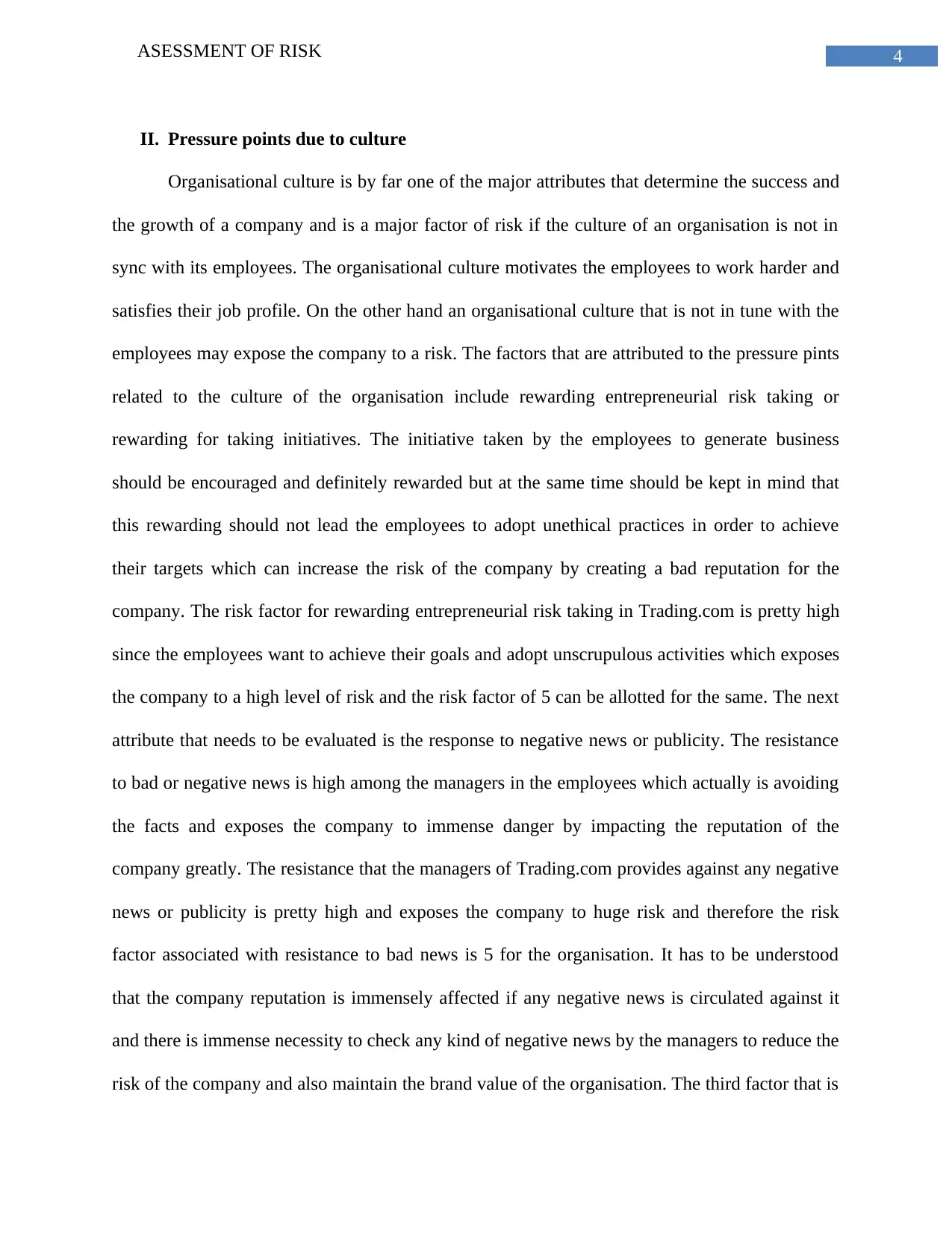
4ASESSMENT OF RISK
II. Pressure points due to culture
Organisational culture is by far one of the major attributes that determine the success and
the growth of a company and is a major factor of risk if the culture of an organisation is not in
sync with its employees. The organisational culture motivates the employees to work harder and
satisfies their job profile. On the other hand an organisational culture that is not in tune with the
employees may expose the company to a risk. The factors that are attributed to the pressure pints
related to the culture of the organisation include rewarding entrepreneurial risk taking or
rewarding for taking initiatives. The initiative taken by the employees to generate business
should be encouraged and definitely rewarded but at the same time should be kept in mind that
this rewarding should not lead the employees to adopt unethical practices in order to achieve
their targets which can increase the risk of the company by creating a bad reputation for the
company. The risk factor for rewarding entrepreneurial risk taking in Trading.com is pretty high
since the employees want to achieve their goals and adopt unscrupulous activities which exposes
the company to a high level of risk and the risk factor of 5 can be allotted for the same. The next
attribute that needs to be evaluated is the response to negative news or publicity. The resistance
to bad or negative news is high among the managers in the employees which actually is avoiding
the facts and exposes the company to immense danger by impacting the reputation of the
company greatly. The resistance that the managers of Trading.com provides against any negative
news or publicity is pretty high and exposes the company to huge risk and therefore the risk
factor associated with resistance to bad news is 5 for the organisation. It has to be understood
that the company reputation is immensely affected if any negative news is circulated against it
and there is immense necessity to check any kind of negative news by the managers to reduce the
risk of the company and also maintain the brand value of the organisation. The third factor that is
II. Pressure points due to culture
Organisational culture is by far one of the major attributes that determine the success and
the growth of a company and is a major factor of risk if the culture of an organisation is not in
sync with its employees. The organisational culture motivates the employees to work harder and
satisfies their job profile. On the other hand an organisational culture that is not in tune with the
employees may expose the company to a risk. The factors that are attributed to the pressure pints
related to the culture of the organisation include rewarding entrepreneurial risk taking or
rewarding for taking initiatives. The initiative taken by the employees to generate business
should be encouraged and definitely rewarded but at the same time should be kept in mind that
this rewarding should not lead the employees to adopt unethical practices in order to achieve
their targets which can increase the risk of the company by creating a bad reputation for the
company. The risk factor for rewarding entrepreneurial risk taking in Trading.com is pretty high
since the employees want to achieve their goals and adopt unscrupulous activities which exposes
the company to a high level of risk and the risk factor of 5 can be allotted for the same. The next
attribute that needs to be evaluated is the response to negative news or publicity. The resistance
to bad or negative news is high among the managers in the employees which actually is avoiding
the facts and exposes the company to immense danger by impacting the reputation of the
company greatly. The resistance that the managers of Trading.com provides against any negative
news or publicity is pretty high and exposes the company to huge risk and therefore the risk
factor associated with resistance to bad news is 5 for the organisation. It has to be understood
that the company reputation is immensely affected if any negative news is circulated against it
and there is immense necessity to check any kind of negative news by the managers to reduce the
risk of the company and also maintain the brand value of the organisation. The third factor that is

5ASESSMENT OF RISK
associated with pressure points due to culture includes internal competition. The internal
competition is important for a work culture but there should be a healthy competition among the
employees. The competitive pressure should not allow adopting practices that can hamper the
growth of the company by either harming the reputation or by creating an atmosphere of
animosity among the employees. The internal competition in Trading.com is extremely high and
the risk factor associated with this internal competition can be allotted as 4 for the organisation.
The pressure points due to culture of Trading.com reveals the following values on the risk
calculator and denotes high level of risk with respect to rewards for taking entrepreneurial risks,
the resistance of executives to bad news and the level of internal competition.
Rewards for taking entrepreneurial risk: 4
Executive resistance to bad news: 5
Level of internal competition: 5
(Appendix 1The Risk exposure Calculator)
III. Pressure points due to information management
The pressure points due to management of information is one of the important aspect of
risk calculation and allows understanding the nature of risk that any organisation is exposed to.
The factors that are affect the management of information include complexity and velocity of
transaction, the gap in diagnostic performance and the degree of decentralised decision making
within an organisation. The complexity and the velocity of the transaction relates to the rate at
which business transactions occur. The greater the velocity and the simplicity of transaction the
company is easier to operate. The complexity and velocity of transaction refers to the passing
down of information related to business transactions, leads and client information and product
related information in an adequate manner and should be ascended in proper manner. The
transaction velocity and complexity in Trading.com has reached an alarming level where the
associated with pressure points due to culture includes internal competition. The internal
competition is important for a work culture but there should be a healthy competition among the
employees. The competitive pressure should not allow adopting practices that can hamper the
growth of the company by either harming the reputation or by creating an atmosphere of
animosity among the employees. The internal competition in Trading.com is extremely high and
the risk factor associated with this internal competition can be allotted as 4 for the organisation.
The pressure points due to culture of Trading.com reveals the following values on the risk
calculator and denotes high level of risk with respect to rewards for taking entrepreneurial risks,
the resistance of executives to bad news and the level of internal competition.
Rewards for taking entrepreneurial risk: 4
Executive resistance to bad news: 5
Level of internal competition: 5
(Appendix 1The Risk exposure Calculator)
III. Pressure points due to information management
The pressure points due to management of information is one of the important aspect of
risk calculation and allows understanding the nature of risk that any organisation is exposed to.
The factors that are affect the management of information include complexity and velocity of
transaction, the gap in diagnostic performance and the degree of decentralised decision making
within an organisation. The complexity and the velocity of the transaction relates to the rate at
which business transactions occur. The greater the velocity and the simplicity of transaction the
company is easier to operate. The complexity and velocity of transaction refers to the passing
down of information related to business transactions, leads and client information and product
related information in an adequate manner and should be ascended in proper manner. The
transaction velocity and complexity in Trading.com has reached an alarming level where the
⊘ This is a preview!⊘
Do you want full access?
Subscribe today to unlock all pages.

Trusted by 1+ million students worldwide
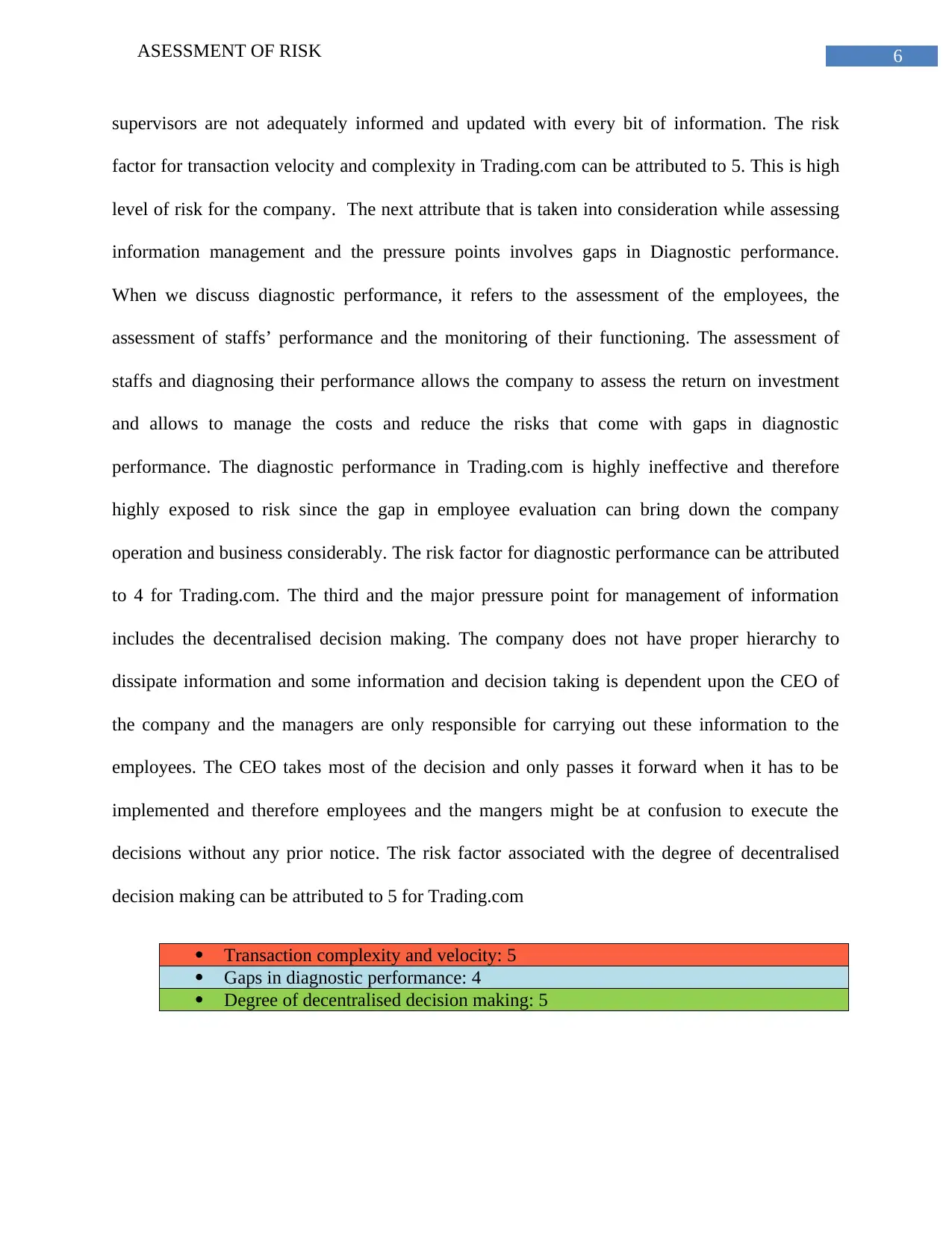
6ASESSMENT OF RISK
supervisors are not adequately informed and updated with every bit of information. The risk
factor for transaction velocity and complexity in Trading.com can be attributed to 5. This is high
level of risk for the company. The next attribute that is taken into consideration while assessing
information management and the pressure points involves gaps in Diagnostic performance.
When we discuss diagnostic performance, it refers to the assessment of the employees, the
assessment of staffs’ performance and the monitoring of their functioning. The assessment of
staffs and diagnosing their performance allows the company to assess the return on investment
and allows to manage the costs and reduce the risks that come with gaps in diagnostic
performance. The diagnostic performance in Trading.com is highly ineffective and therefore
highly exposed to risk since the gap in employee evaluation can bring down the company
operation and business considerably. The risk factor for diagnostic performance can be attributed
to 4 for Trading.com. The third and the major pressure point for management of information
includes the decentralised decision making. The company does not have proper hierarchy to
dissipate information and some information and decision taking is dependent upon the CEO of
the company and the managers are only responsible for carrying out these information to the
employees. The CEO takes most of the decision and only passes it forward when it has to be
implemented and therefore employees and the mangers might be at confusion to execute the
decisions without any prior notice. The risk factor associated with the degree of decentralised
decision making can be attributed to 5 for Trading.com
Transaction complexity and velocity: 5
Gaps in diagnostic performance: 4
Degree of decentralised decision making: 5
supervisors are not adequately informed and updated with every bit of information. The risk
factor for transaction velocity and complexity in Trading.com can be attributed to 5. This is high
level of risk for the company. The next attribute that is taken into consideration while assessing
information management and the pressure points involves gaps in Diagnostic performance.
When we discuss diagnostic performance, it refers to the assessment of the employees, the
assessment of staffs’ performance and the monitoring of their functioning. The assessment of
staffs and diagnosing their performance allows the company to assess the return on investment
and allows to manage the costs and reduce the risks that come with gaps in diagnostic
performance. The diagnostic performance in Trading.com is highly ineffective and therefore
highly exposed to risk since the gap in employee evaluation can bring down the company
operation and business considerably. The risk factor for diagnostic performance can be attributed
to 4 for Trading.com. The third and the major pressure point for management of information
includes the decentralised decision making. The company does not have proper hierarchy to
dissipate information and some information and decision taking is dependent upon the CEO of
the company and the managers are only responsible for carrying out these information to the
employees. The CEO takes most of the decision and only passes it forward when it has to be
implemented and therefore employees and the mangers might be at confusion to execute the
decisions without any prior notice. The risk factor associated with the degree of decentralised
decision making can be attributed to 5 for Trading.com
Transaction complexity and velocity: 5
Gaps in diagnostic performance: 4
Degree of decentralised decision making: 5
Paraphrase This Document
Need a fresh take? Get an instant paraphrase of this document with our AI Paraphraser

7ASESSMENT OF RISK
Conclusion:
Thus by evaluating the pressure points of Trading.com, the risk calculator estimates the
risk to be at the value of 41 which puts the company at a very high risk and makes the company
vulnerable to losses and failure in business. It is immensely important for the top management of
the company to assess the risks and evaluate them to adopt policies and framework that can be
implemented and would reduce the amount of risk that the company is exposed to and thereby
make the company profitable in the long run. The pressure points as discussed in the paper is
extremely important to be monitored and managed adequately since these pressure points are the
key to success and failure of any organisation. The factors of organisational growth and culture
and information management needs to be addressed with necessary importance and management
of the staffs and the employees are also integral in reducing the risk that Trading.com is exposed
to. It is therefore necessary that the modifications and implementations are done accordingly to
derive effective result.
Conclusion:
Thus by evaluating the pressure points of Trading.com, the risk calculator estimates the
risk to be at the value of 41 which puts the company at a very high risk and makes the company
vulnerable to losses and failure in business. It is immensely important for the top management of
the company to assess the risks and evaluate them to adopt policies and framework that can be
implemented and would reduce the amount of risk that the company is exposed to and thereby
make the company profitable in the long run. The pressure points as discussed in the paper is
extremely important to be monitored and managed adequately since these pressure points are the
key to success and failure of any organisation. The factors of organisational growth and culture
and information management needs to be addressed with necessary importance and management
of the staffs and the employees are also integral in reducing the risk that Trading.com is exposed
to. It is therefore necessary that the modifications and implementations are done accordingly to
derive effective result.
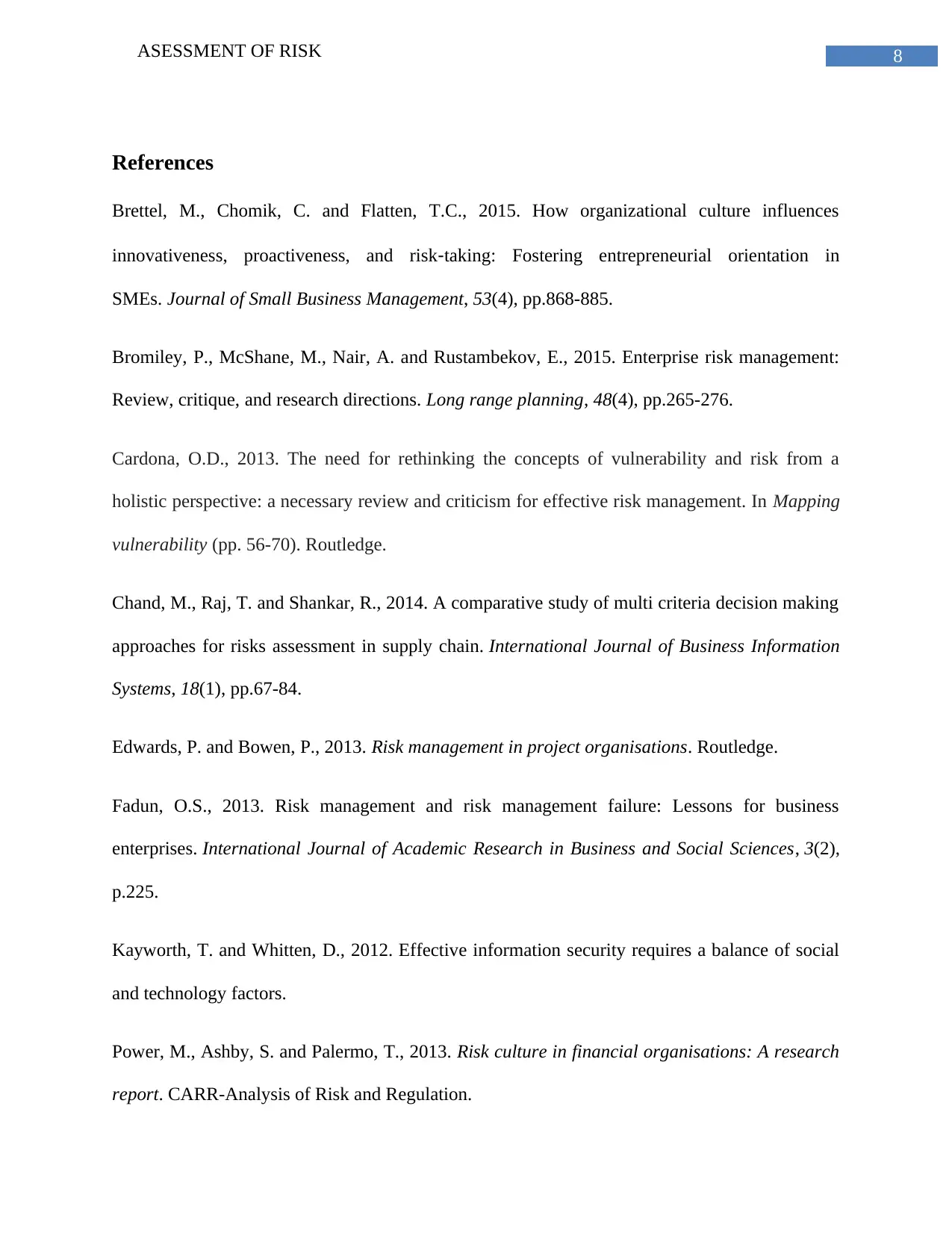
8ASESSMENT OF RISK
References
Brettel, M., Chomik, C. and Flatten, T.C., 2015. How organizational culture influences
innovativeness, proactiveness, and risk‐taking: Fostering entrepreneurial orientation in
SMEs. Journal of Small Business Management, 53(4), pp.868-885.
Bromiley, P., McShane, M., Nair, A. and Rustambekov, E., 2015. Enterprise risk management:
Review, critique, and research directions. Long range planning, 48(4), pp.265-276.
Cardona, O.D., 2013. The need for rethinking the concepts of vulnerability and risk from a
holistic perspective: a necessary review and criticism for effective risk management. In Mapping
vulnerability (pp. 56-70). Routledge.
Chand, M., Raj, T. and Shankar, R., 2014. A comparative study of multi criteria decision making
approaches for risks assessment in supply chain. International Journal of Business Information
Systems, 18(1), pp.67-84.
Edwards, P. and Bowen, P., 2013. Risk management in project organisations. Routledge.
Fadun, O.S., 2013. Risk management and risk management failure: Lessons for business
enterprises. International Journal of Academic Research in Business and Social Sciences, 3(2),
p.225.
Kayworth, T. and Whitten, D., 2012. Effective information security requires a balance of social
and technology factors.
Power, M., Ashby, S. and Palermo, T., 2013. Risk culture in financial organisations: A research
report. CARR-Analysis of Risk and Regulation.
References
Brettel, M., Chomik, C. and Flatten, T.C., 2015. How organizational culture influences
innovativeness, proactiveness, and risk‐taking: Fostering entrepreneurial orientation in
SMEs. Journal of Small Business Management, 53(4), pp.868-885.
Bromiley, P., McShane, M., Nair, A. and Rustambekov, E., 2015. Enterprise risk management:
Review, critique, and research directions. Long range planning, 48(4), pp.265-276.
Cardona, O.D., 2013. The need for rethinking the concepts of vulnerability and risk from a
holistic perspective: a necessary review and criticism for effective risk management. In Mapping
vulnerability (pp. 56-70). Routledge.
Chand, M., Raj, T. and Shankar, R., 2014. A comparative study of multi criteria decision making
approaches for risks assessment in supply chain. International Journal of Business Information
Systems, 18(1), pp.67-84.
Edwards, P. and Bowen, P., 2013. Risk management in project organisations. Routledge.
Fadun, O.S., 2013. Risk management and risk management failure: Lessons for business
enterprises. International Journal of Academic Research in Business and Social Sciences, 3(2),
p.225.
Kayworth, T. and Whitten, D., 2012. Effective information security requires a balance of social
and technology factors.
Power, M., Ashby, S. and Palermo, T., 2013. Risk culture in financial organisations: A research
report. CARR-Analysis of Risk and Regulation.
⊘ This is a preview!⊘
Do you want full access?
Subscribe today to unlock all pages.

Trusted by 1+ million students worldwide
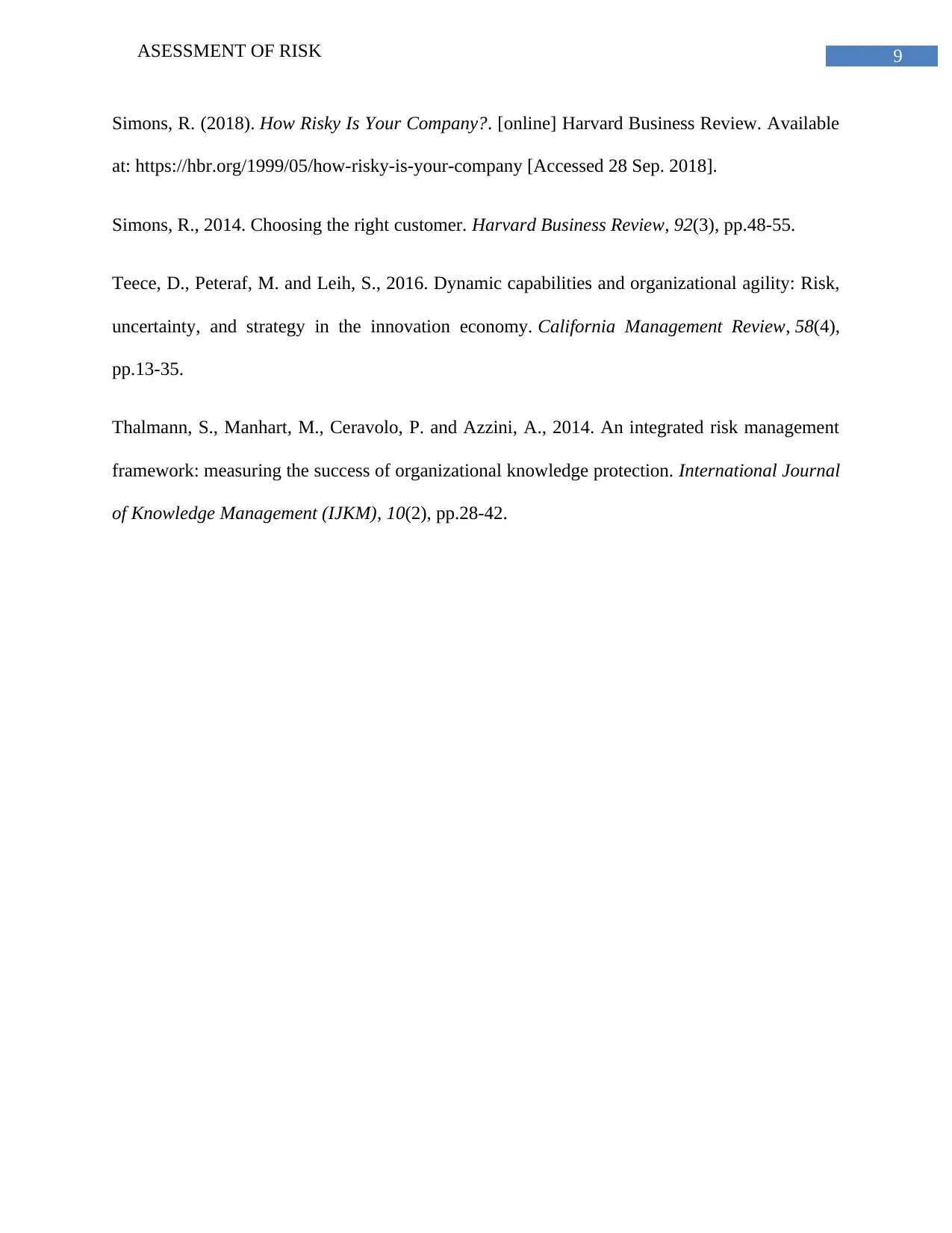
9ASESSMENT OF RISK
Simons, R. (2018). How Risky Is Your Company?. [online] Harvard Business Review. Available
at: https://hbr.org/1999/05/how-risky-is-your-company [Accessed 28 Sep. 2018].
Simons, R., 2014. Choosing the right customer. Harvard Business Review, 92(3), pp.48-55.
Teece, D., Peteraf, M. and Leih, S., 2016. Dynamic capabilities and organizational agility: Risk,
uncertainty, and strategy in the innovation economy. California Management Review, 58(4),
pp.13-35.
Thalmann, S., Manhart, M., Ceravolo, P. and Azzini, A., 2014. An integrated risk management
framework: measuring the success of organizational knowledge protection. International Journal
of Knowledge Management (IJKM), 10(2), pp.28-42.
Simons, R. (2018). How Risky Is Your Company?. [online] Harvard Business Review. Available
at: https://hbr.org/1999/05/how-risky-is-your-company [Accessed 28 Sep. 2018].
Simons, R., 2014. Choosing the right customer. Harvard Business Review, 92(3), pp.48-55.
Teece, D., Peteraf, M. and Leih, S., 2016. Dynamic capabilities and organizational agility: Risk,
uncertainty, and strategy in the innovation economy. California Management Review, 58(4),
pp.13-35.
Thalmann, S., Manhart, M., Ceravolo, P. and Azzini, A., 2014. An integrated risk management
framework: measuring the success of organizational knowledge protection. International Journal
of Knowledge Management (IJKM), 10(2), pp.28-42.
Paraphrase This Document
Need a fresh take? Get an instant paraphrase of this document with our AI Paraphraser
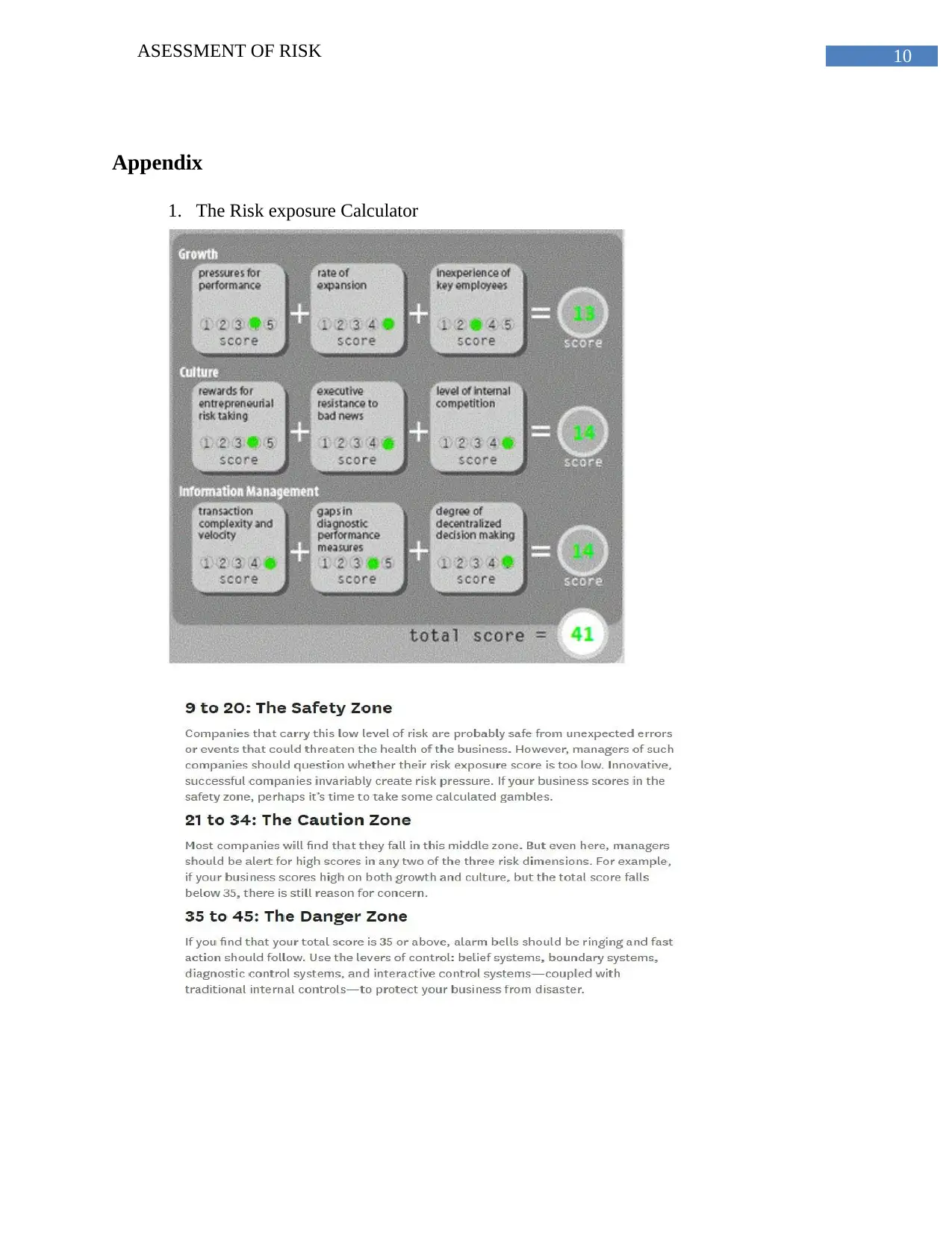
10ASESSMENT OF RISK
Appendix
1. The Risk exposure Calculator
Appendix
1. The Risk exposure Calculator
1 out of 11
Related Documents
Your All-in-One AI-Powered Toolkit for Academic Success.
+13062052269
info@desklib.com
Available 24*7 on WhatsApp / Email
![[object Object]](/_next/static/media/star-bottom.7253800d.svg)
Unlock your academic potential
Copyright © 2020–2025 A2Z Services. All Rights Reserved. Developed and managed by ZUCOL.




